The PCU Protective Combat Uniform: A Buyer’s Guide and Clothing System History
The PCU Protective Combat Uniform: A Buyer’s Guide and Clothing System History
During the early part of the war in Afghanistan, US forces were suffering under extreme cold weather conditions; poorly served by their issued clothing systems. Enter the PCU.
In 2002, US Army Master Sergeant Tony “Bucket” Pryor, who would later go on to be awarded a Silver Star, made a satellite call from the Hindu Kush to Rick Elder of the Special Projects Team at the Natick Soldier Systems Center. Pryor demanded that Natick come up with a better solution for keeping soldiers warm in that environment.
Elder assembled a team to address this problem, including Master Chief Scott Williams, the former OIC (officer in charge) of the Naval Special Warfare Detachment in Kodiak, Alaska, where newly minted Navy SEALs go for their cold weather training. Elder also leaned on civilians with extensive cold weather experience like Mark Twight and within a year, they developed and issued an interchangeable clothing system called the PCU, or Protective Combat Uniform, which provided comprehensive cold weather options for our warfighters.
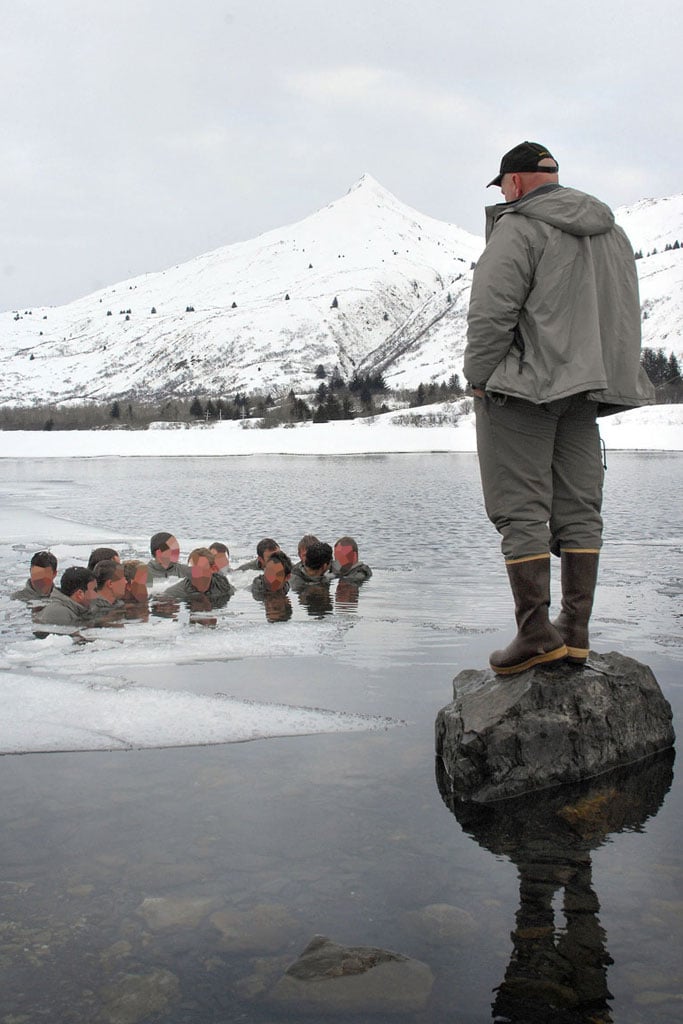
The PCU is divided into seven “levels,” which to be clear, are not seven layers to be necessarily worn on top of each other, but rather a variety of different “levels” which could be combined with one another for various atmospheric and environmental conditions. It’s comprised of sixteen different garments, each providing different complementary functionality to the overall system.
The PCU Backstory – ECWCS and Natick
In 1949, what would later become the Natick Soldier Systems Center (frequently referred to as “Natick Army Labs”) was authorized by Congress. By 1952, construction had begun on facilities which would become the primary research and development center for technologies fielded by the United States Army in the decades to come.
By the 1980s, Natick was developing what would become the ECWCS (Extended Cold Weather Clothing System), which began issuing to soldiers around 1986. Though the ECWCS system would see further generational development many years later, the changes made to ECWCS did not reflect the pace in which civilian cold weather clothing had progressed. Hence Pryor’s phone call from the mountains of Afghanistan.
The development of the PCU system was a radical rethinking of the both the underlying premises of such a clothing system and a chance to incorporate the revolutionary new textiles that civilian mountaineering had seen fundamentally change their field.
Mark Twight – The PCU Godfather
At the time he joined the PCU project, Mark Twight already had two decades of experience on multiple continents as a mountaineer. He’d also been doing technical advisory work for outdoor clothing manufacturers like Patagonia, for whom he’d helped develop their now-ubiquitous Regulator system.
When Rick Elder contacted Twight about helping to design the new PCU system, Twight was honored. He took it as an opportunity to try and give back to the armed forces, who he felt had allowed him to pursue a life doing what he loved and use the knowledge that his experience had imparted.
The video above was taken from a more comprehensive PCU instructional video that was produced many years ago, featuring Mark Twight and his team walking the viewer through the system.
The Protective Combat Uniform
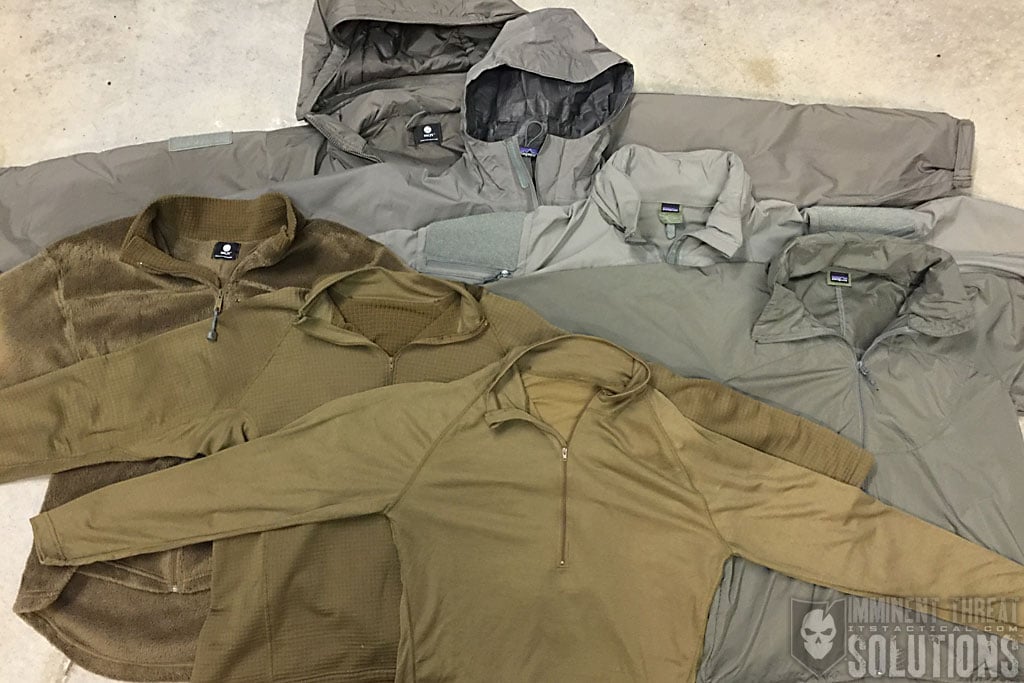
Natick’s PCU project is a multi-level system which helps protect the soldier from cold and wet weather, ranging from 45 degrees down to -50 degrees Fahrenheit. The system is lightweight and highly compressible, reducing the amount of space it requires in a load out, as well as reducing the total weight being carried by the soldier wearing it.
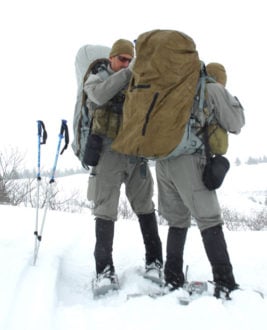 The PCU system use differs between individuals and their mission. While some basic guidelines are provided as sample data for various specific weather conditions, it’s important for the individual user to experiment with different combinations to determine what works best for them for each situation. Different body types and different metabolic rates will mean different level combinations for each person.
The PCU system use differs between individuals and their mission. While some basic guidelines are provided as sample data for various specific weather conditions, it’s important for the individual user to experiment with different combinations to determine what works best for them for each situation. Different body types and different metabolic rates will mean different level combinations for each person.
A fundamental premise of the PCU system is adaptability. Mission planning is imperfect, as situations rapidly change and weather forecasting is an imprecise science.
The atmospheric conditions one expects might end up being entirely incorrect. Being able to adapt to changes in external or mission conditions can potentially mean the difference between life and death, or mission success vs. mission failure.
Don’t Stay Dry, Dry Quickly Instead
The PCU system consists of synthetic materials that don’t retain water. While they may become wet, either from external moisture, or moisture generated by activity (sweating,) they’re designed to dry quickly. The use of these materials stems from experiences of Scottish mountaineers, who determined that it was impossible to stay perfectly dry. As a result, the superior strategy was to don materials that would shed water as fast as possible.
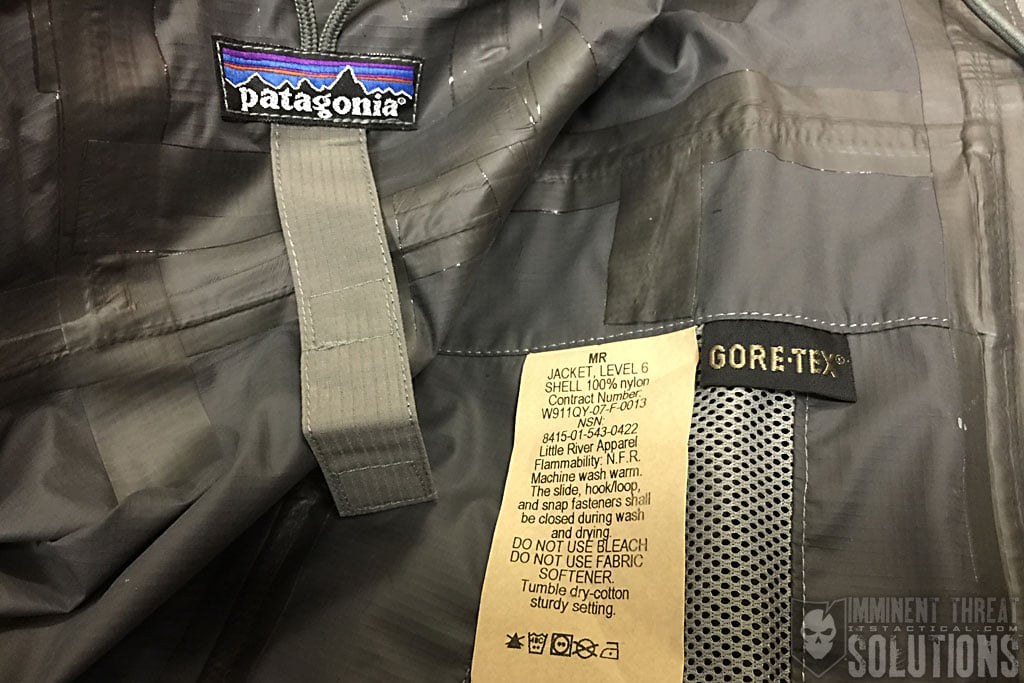
This thought process resulted in the implementation of soft shell materials, pioneered early on by companies like Snugpak. Unlike the earlier ECWCS system, which relied on insulation under a Gore-Tex hard shell, the PCU system leans on the use of a more breathable, though less “waterproof” outer soft shell layer.
Gore-Tex is a porous Teflon film material, relying on a tight weave which disallows water from entering in liquid state, but still allows water to exit while in vapor state. In addition to the soft shell layer, insulation layers that can’t hold water are also utilized, resulting in more efficient “wicking” of moisture towards the outer layer being worn.
How It Works
The PCU emphasizes durability and functionality and has been described as the best cold weather clothing system ever developed. The primary operational theory for how it works requires some understanding of physics, so buckle in.
In any clothing system, moisture will move into or out of the system based on the differences in temperature and pressure between the two zones, described as the “microclimate.” This is the area inside the garments between where the human resides and the “macroclimate” environment outside the clothing system.
When the temperature in the macroclimate is lower than the temperature in the microclimate, the tendency is for moisture to move away from the body, toward the outside of the clothing. The difference in temperatures tries to equalize, which pushes the water vapor outward. In the event of liquid perspiration, the wicking properties of the insulation layers performs that same task of constantly moving moisture towards the macroclimate. When humidity is the same inside and outside, water stays inside the system.
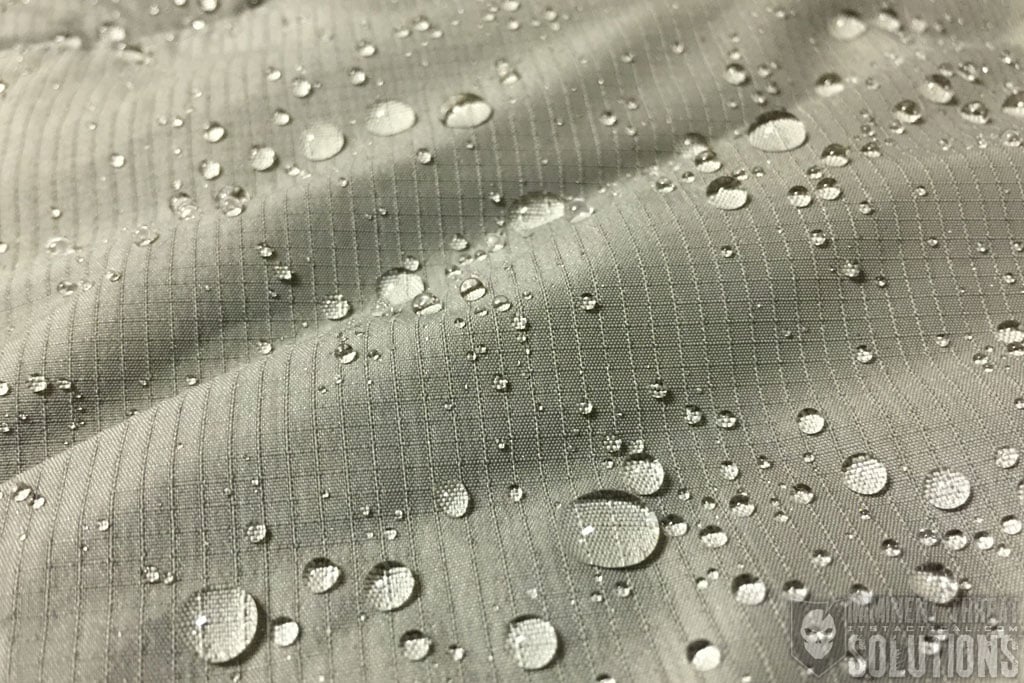
While Gore-Tex is still a component of the PCU system, its use is minimized to specific conditions in which there is significantly more moisture outside the system than inside the system. The Level 5 soft shell is a more crucial piece of the PCU because of the various conditions in which Gore-Tex fails to perform:
- If the pores of the Gore-Tex fabric becomes saturated, moisture will fail to evaporate from the shell.
- If the shell gets cold and moisture inside freezes, bonding the insulation layer to the shell, this prohibits the movement of vapor and moisture towards the outside of the system.
- If the user is not in motion and is losing heat, rather than generating heat, the rate of moisture transfer will lower, significantly reducing efficient transfer.
The Level 5 soft shell, in comparison, is water resistant, but by no means waterproof. It’s made, like all of the other parts of the PCU system, of hydrocarbon materials, aka “plastic,” which cannot absorb water. The soft shell is also windproof, creating significantly less of a barrier for vapor transmission than the Level 6 Gore-Tex shell and requiring less pressure to push moisture out into the atmosphere.
Combined with the other level garments, the goal is always to move the “dew point” away from the body and towards the macroclimate. The PCU system is a constantly self-drying soft-shell system, reinforced with hard shell components, which dries as quickly as possible when it gets wet.
In testing the system, users are encouraged to get wet before starting, in order to see just how quickly water is forced out of the system. After submerging the system, the wearer engages in movement on land, which results in the next-to-skin clothing being dry in about 15 minutes and the entire clothing system being dry within 60 minutes.
Despite these statistics, water can and does tend to collect in the insulation layers towards the waist and wrists due to gravity. Regardless, this remains preferable to systems which remain wet and retain water within them. Cotton, for example, absorbs almost 100% of its weight in water and holds on to it indefinitely. Remember the old outdoor adage, “Cotton is rotten.”
Action vs. Static
The PCU is designed to provide for both static and kinetic situations, meaning that whether you’re on the move carrying a load and generating heat, or you’re stationary and likely losing heat, the PCU can be adjusted to keep you warm and dry.
This is achieved by adding the appropriate level garment to the system you started with. For example, if you rucked for a few miles wearing the Level 4 windshirt, Level 1 or 2 insulation and the Level 5 soft shell, but then needed to stay in one place not moving for a few hours, you could pull out your Level 7 parka and put it on over everything else, providing a barrier to retain heat, while still pushing moisture away from your body.
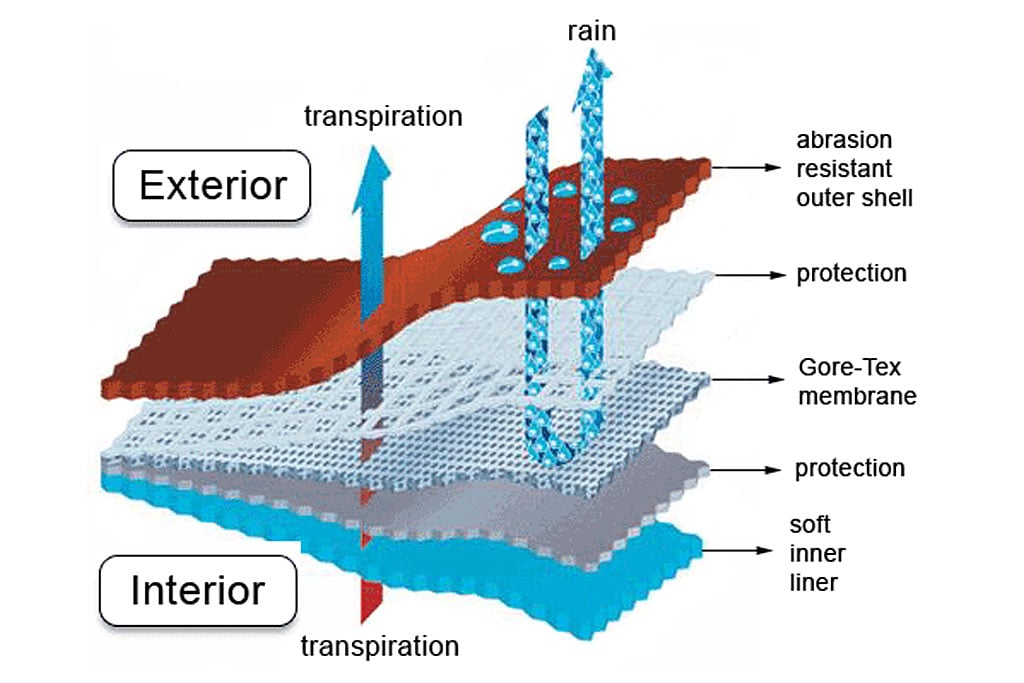
The goal of the PCU is to stabilize body temperature, which it accomplishes with increased breathability and expanded functionality of the system, overall. Let’s say after remaining static for a few hours, you needed to move out again, you’d then simply remove and stow your Level 7 parka and/or pants and begin moving, generating heat again from your physical exertion to keep you warm.
There are a few different types of heat loss we need to touch on below, so you have the whole picture.
Evaporative heat loss is due to moisture evaporating from the body, which causes a rapid cooling effect, sometimes referred to as “flash off.”
Convective heat loss is the result of cold air moving over the surface of a body, like wind, sometimes resulting from the bellowing of baggy clothes. This is called the “chimney effect.”
Conductive heat loss comes from direct contact wherein heat transfers from the warmer object (you) to a cold object (a rock you chose to sit on, frozen ground, etc.)
Radiant heat loss is caused by infrared release, like when the sun sets and you’re no longer basked in direct sunlight.
Finally, there’s heat loss which is a combination of evaporative and convective heat loss. This is experienced by breathing in extremely cold air, which circulates inside your body before being exhaled, facilitating evaporative heat loss.
Even when wet, PCU textiles consistently self-dry and remain warm. In the Action Subsystem, pressure differential makes the system work, forcing the vapor away from the body while retaining the heat the body is generating inside. In the Static Subsystem, the Level 7 garment provides a thermal barrier to retain heat, while the Level 6 garment provides a precipitation barrier to keep excess macroclimate moisture outside the system.
In previous cold weather clothing systems, the process of warming up a wet soldier consisted of stripping off the wet layers and adding insulation. In the new PCU system, insulation is layered over everything else. Again, the goal with the PCU is to constantly move the dew point away from the body, rather than trying to achieve the unachievable goal of keeping water outside the system. This is done by forcing out remaining water inside the system, leaving the individual comfortable and dry.
Level by Level
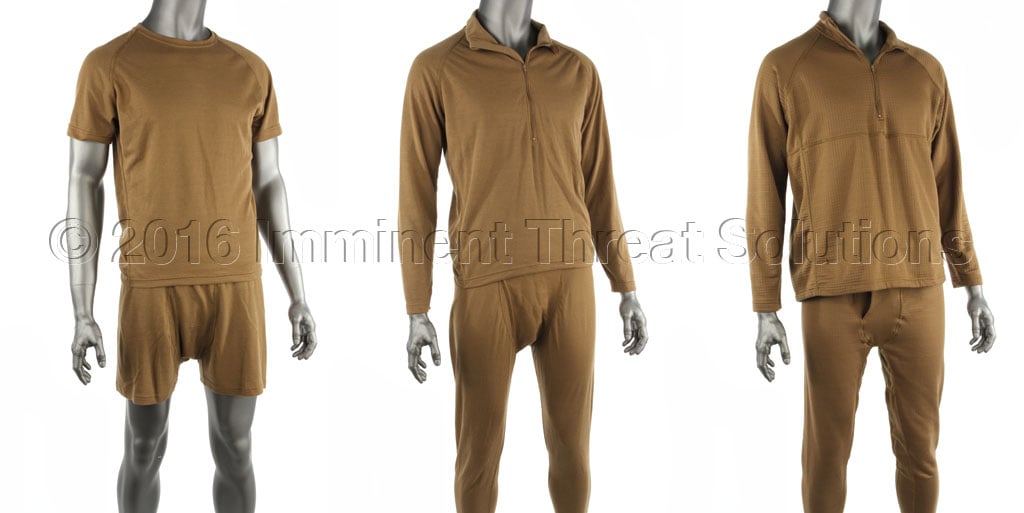
Level 1 is generally the next-to-skin garments, though Level 1A and Level 2 garments can also fill this role. Level 1 is comprised of moisture wicking silk weight boxers and t-shirt (short sleeved).
Level 1A is made up of the same moisture wicking shirt and pant elements for wear next-to-skin, but differs in that Level 1A is long-sleeved and full-leg in nature and can be slightly thicker than the Level 1 boxer and t-shirt.
Level 2 is comprised of a mid-weight pullover and long pant in waffle-pattern fleece that sucks moisture away from the skin, pushing it outward.
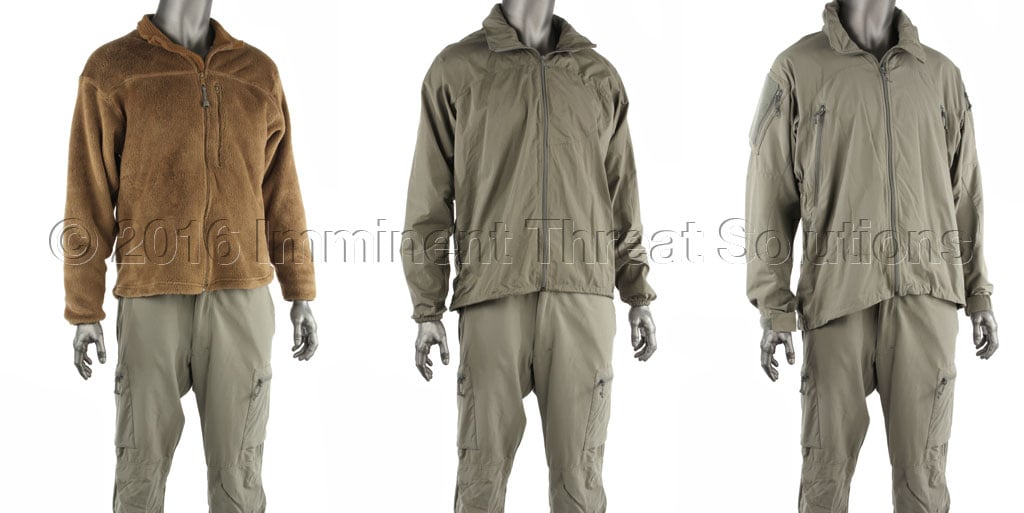
Level 3 is a heavyweight fleece jacket that’s very warm and dries quickly. However, it’s not generally ideal in action situations due to the amount of warmth it retains, which can result in overheating when the user is in motion and generating a lot of heat.
Level 4 consists of a thin, windproof “wind shirt,” which is intended for use inside the system, though it can be worn as an outer layer. Generally it’s worn under other layers and helps retain 300% more heat than without a wind shirt. It is ideal in escape and evasion situations, as it’s very compact and can be rolled up and stuffed in a cargo pocket. It’s less durable than the Level 5 soft shell garments and not meant for high abrasion situations like low-crawling over rocks or work in which the wearer is getting into and out of vehicles with some frequency. It’s frequently worn as an under-layer beneath the soldier’s camouflage uniform and in helicopter use, or other situations with significant environmental wind.
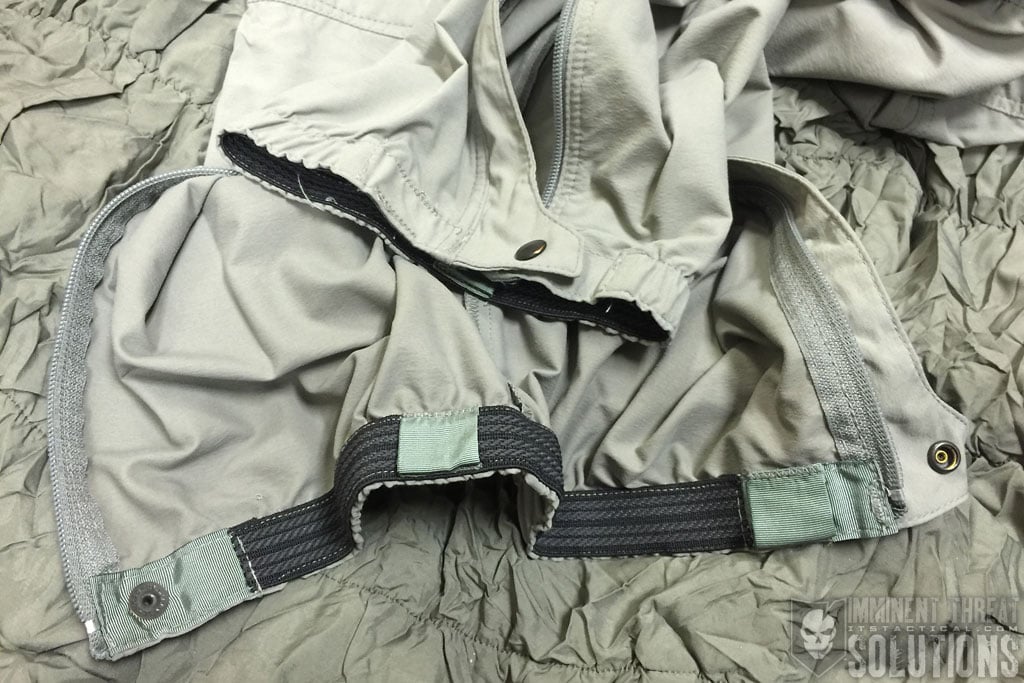
Level 5 and its soft shell jacket and pants are the cornerstone of the PCU system. In cold weather conditions, the L5 jacket and pants replace the wearing of a camouflage uniform and features tie-downs inside the pockets for stowing gear, a hood on the jacket for use under a helmet and pants can be modified with 550 paracord to form makeshift gaiters to keep snow outside the wearer’s footwear.
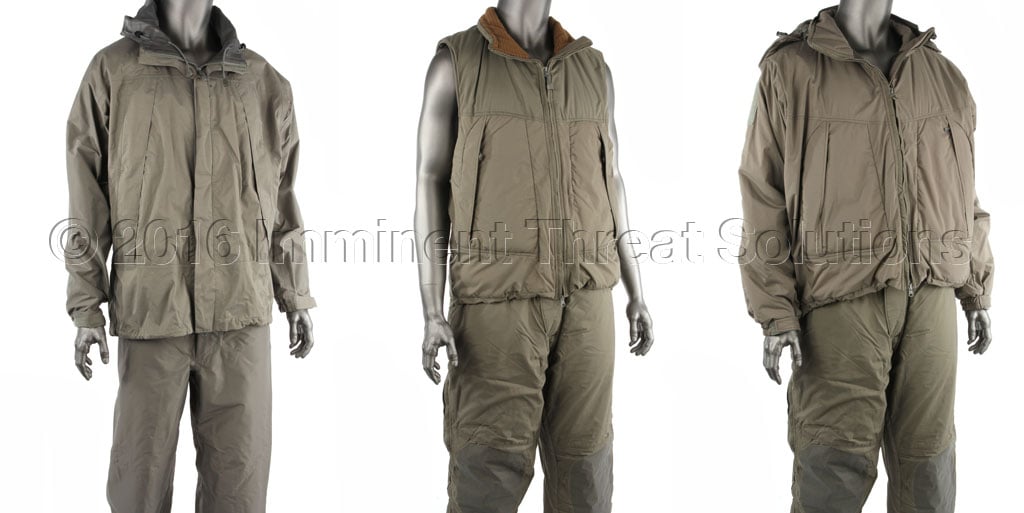
Level 6 consists of a Gore-Tex hard shell jacket and pant for wearing over light load carriage. Level 6 garments are breathable, though less so than Level 5 and are sized to go over the Level 5 garments. The L6 pants have 3/4 length zippers on the legs, allowing for donning them over boots with relative ease.
Level 7 is made up of a high-loft jacket, vest and pants, to be worn atop the other PCU components. Level 7 garments are water resistant and breathable. The L7 Type 1 jacket is sized like a normal jacket and features mesh pockets for rapid drying of gloves and socks inside the jacket. The L7 Type 2 jacket is geared towards mobility, and is designed to go over a soldier’s body armor and a light assault pack.
It features two closure systems; both velcro and a zipper. It also has a waist and lower drawstring, which allows it to be tightened down to be more like the L7 Type 1 jacket. The L7A Vest is designed to be worn under either the Type 1 or Type 2 L7 jackets in order to provide extra insulation for temperatures as low as -50 degrees. Finally, the L7 pant is designed for wear over the other layers of insulation. Its knees and seat are reinforced with abrasion-resistant materials and it’s legs can be converted to gaiter duty in a manner similar to the L5 pants with a small amount of paracord.
Fit and Finish
The fit of the PCU system is scaled towards the average size of SOF (Special Operations Forces) personnel, which is to say that individual garments may be a little larger than their civilian equivalents. This is due to the average operator being a little beefier than the average civilian.
However, companies like Beyond Clothing have the ability to tailor the various garments to any given individual, through a process that starts with taking some comprehensive measurements of that individual before being custom built to that user’s specifications. As a result, the PCU can be made to fit anyone, big or small.
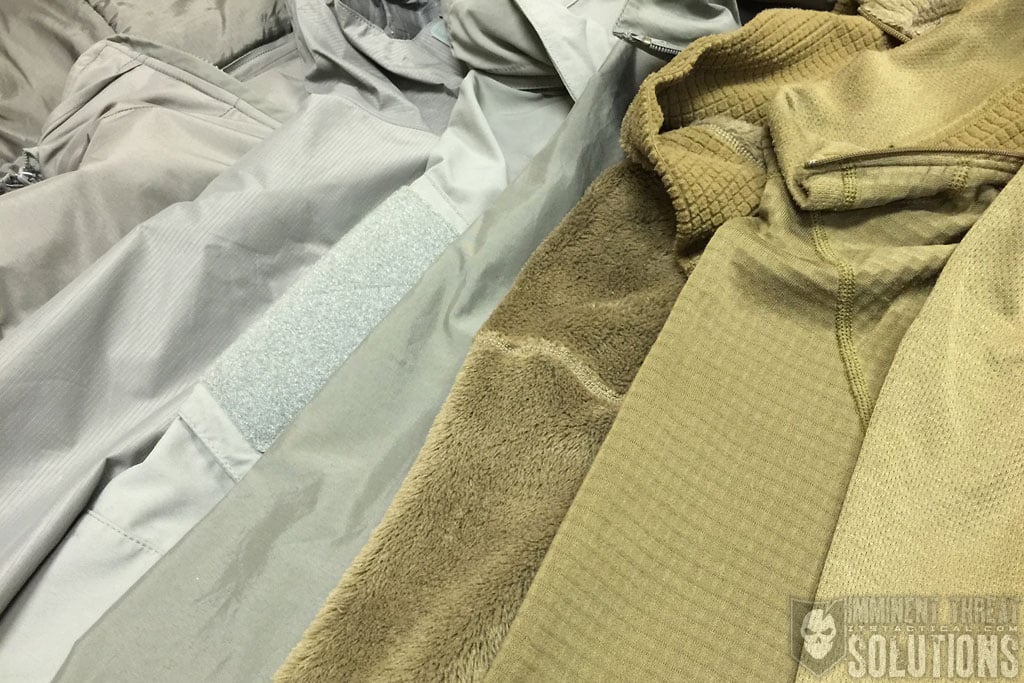
As a whole, the PCU system tends to fit a little more snugly than some outdoor clothing and even more so than standard military uniforms. The fit of the garments is designed to complement the layering of the various elements of the system, while still allowing for maximum mobility through stretchable fabrics like those used in the L5 soft shell garments. Arms tend to also be a little longer to accommodate the use and carriage of weapons in any given position, from standing to prone positions.
Planning and Packing
For military users of the PCU system, the entire system is issued as one big bag full of gear. This comes with documents on the use and care of the garments and can also ship with the information-packed QuickPoint Visual User’s Guide, which serves as a valuable starting reference point to help the wearer know what sort of atmospheric or mission conditions work with what specific combinations of PCU garments.
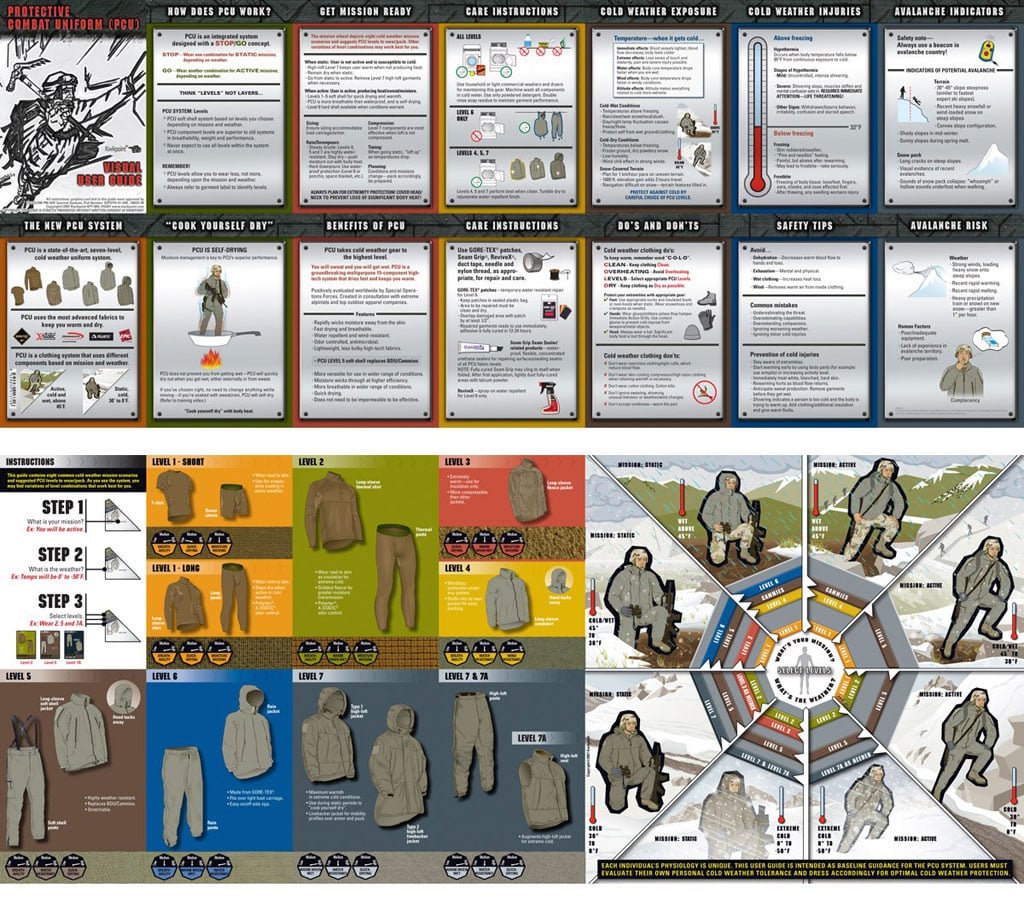
The system is best used in varying combinations and is not meant to be layered sequentially, meaning one garment on top of another, on top of another, until you’re wearing all seven levels. The conditions of your operating environment and the requirements of your mission will determine not only what you wear, but also what you stow in your pack for later use. The wind shirt (Level 4), in particular, is a very versatile garment meant to be sandwiched between your various layers. It allows for a more stable internal temperature to be managed, as well as reducing friction between insulation layers.
Further, the axiom of dressing smarter, not larger, applies; this is where trying the various levels together in various field conditions is a huge benefit. What might work for most people may not work for an individual and there’s no substitute for personal experience in determining what works best for any given situation.
When packing up for a given journey or mission, you wouldn’t want to just stuff it all in your pack. Despite the fact these garments are lightweight, individually, the collective weight does add up. Knowing what you might need and what you won’t will help your decision in what to bring.
Packing smarter also includes knowing where to place garments inside your pack. If you’re going into a mountainous environment and you know it’s going to be cold and dry, you’re probably going to want to stash your L7 parka or jacket in the top of your pack for easy access. When you stop moving, you’ll want to reach into the top of your pack and pull out your thermal insulation right away, without having to dig under a bunch of other things to get to it. As soon as you stop moving and start standing still, you’ve just gone from an active scenario to a static scenario and you’ll start losing heat. Addressing that before you notice that you’re losing heat is to your advantage.
At the same time, you may want to wear less when you first set out, despite the fact you may be cold. Once you start moving, you’ll start heating up. Getting the insulation layers right, particularly the torso insulation layers, is key to your comfort and effectiveness. Leg insulation is less important, though you’ll still want to get that as correct up front as you possibly can, given that it’s more of a pain in the ass to add or remove leg insulation once you’re out in the field.
Accessories
The PCU is an outstanding clothing system for cold weather environments, but it’s not entirely comprehensive. It doesn’t include gloves, mittens, hats, socks, or footwear. There are many options for all of these items, obviously; in the civilian world, the choices may be even more plentiful, but in the military world, the approved choices for these are still solid. Companies like Outdoor Research have some fantastic options for gloves, mittens and head coverings for government clients and civilians alike.
There’s another item that complements the Level 7 gear, previously made by Sierra Designs, that to the best of our knowledge it’s no longer made, but still worth mentioning. That item is known as the “Elephant’s Foot” and is (was) a 3/4 length sleeping bag with suspenders and an opening bottom, featuring shingled Primaloft construction that effectively doubles the insulation.
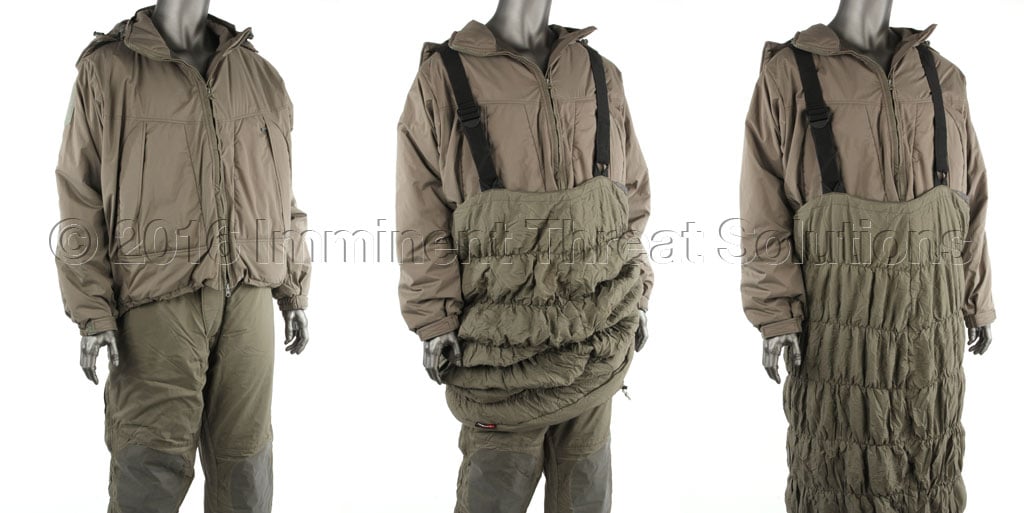
The Elephant’s Foot served as a sleeping bag when used in conjunction with the L7 jacket and pants, but it also allowed you to open the bottom of it easily, hike it up and do your business without having to remove it. It also allowed quick mobility in the event that, while sleeping, something went horribly wrong. We have confirmed with Sierra Designs that they no longer make this piece, but it could always pop up on the secondary market.
Who Makes This Stuff?
Since 2002, a number of manufacturers have held federal contracts to produce specific PCU garments and sometimes to produce every garment in the system. The system has undergone revisions and modifications, divided into “Blocks” or generations over time. No one company has held a PCU contract for the entirety of its existence, though some companies have held the contract, then held it again. ORC Industries, Patagonia, Beyond Clothing, Halys, Wild Things Gear, Propper, Blackhawk and others have all produced part, or all, of the PCU system since its inception.
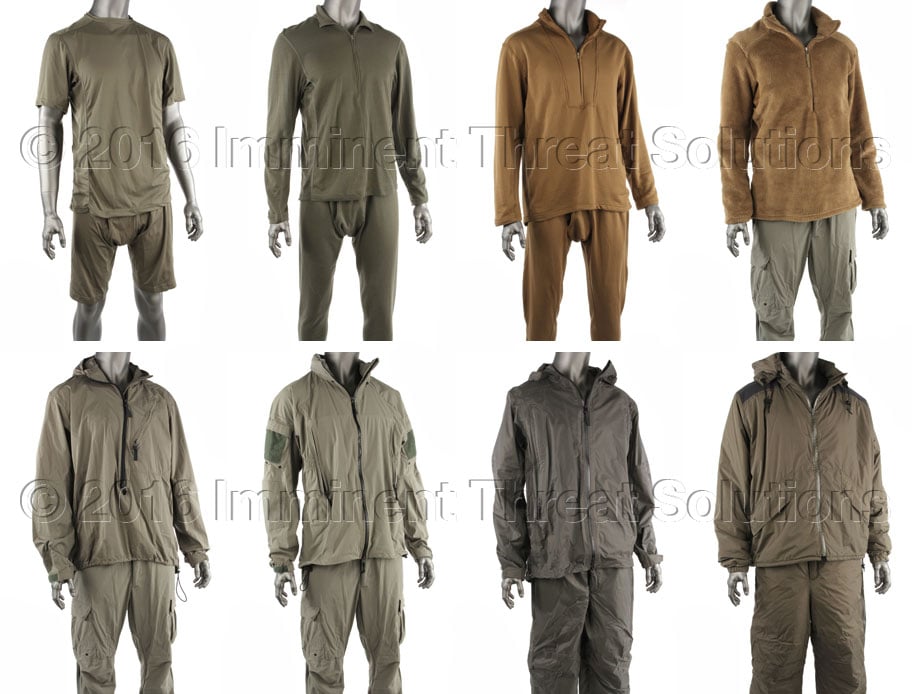
This being the case, the evolution of the PCU can been seen in two primary generations. The first, dubbed block 0 (shown above,) was issued beginning in 2003. Block 1 came along after improvements were mandated and began fielding in 2006 (shown below.)
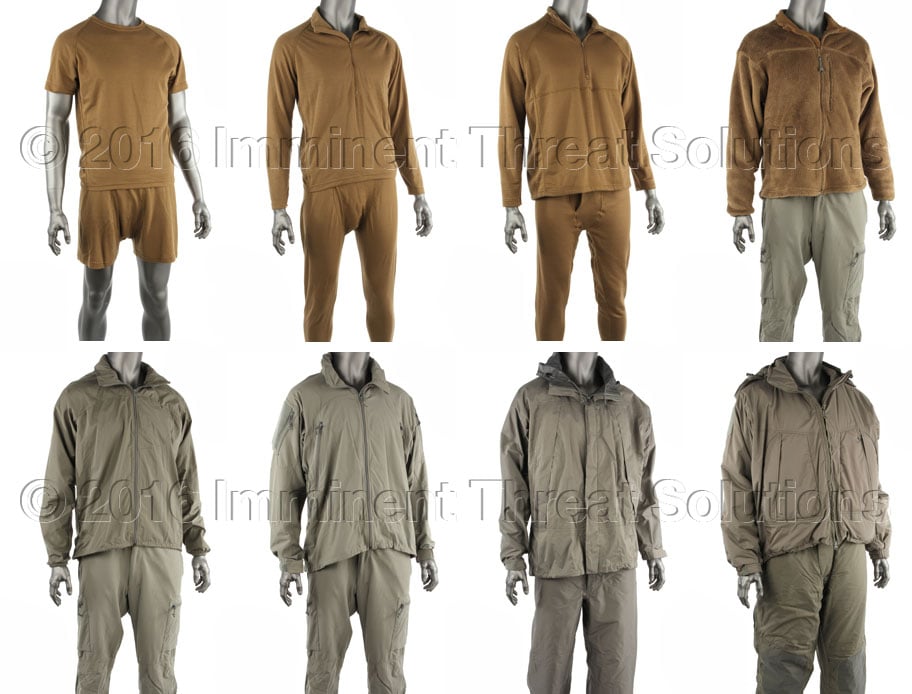
Block 2 details have since been released on Soldier Systems by Editor-in-Chief, Eric Graves, back in early 2012 and are reflective of what’s currently being issued. Included in that Block 2 release, are details of Level 8, which is just a placeholder for future use and not a currently produced garment level. Also mentioned is the Level 9 Combat Uniform, which can be thought of as a more modern and up to date version of traditional BDUs (battle dress uniform,) AKA camouflage fatigues or cammies.
The telltale feature changes between blocks are numerous and yet largely still resemble each other between blocks 0 and 1. Block 2 includes marked changes to certain level garment fabrics and even additional garments altogether, like Level 3a and 3b. For more on these changes, check out this Soldier Systems article.
Where You Can Get the PCU?
ADS currently sells the PCU System to approved government buyers and both Patagonia and Beyond Clothing are actively manufacturing garments in the system. Beyond allows civilians to purchase the items directly, though Patagonia’s offerings can largely only be bought used via eBay or other similar places.
For the most part, Patagonia seems to downplay the fact that they make the PCU, which may be to minimize unwanted feedback from their largely crunchy-granola customer base. However, every once in a while you can find particular pieces creeping into their normal line-up, like this Level 3A jacket from the the PCU.
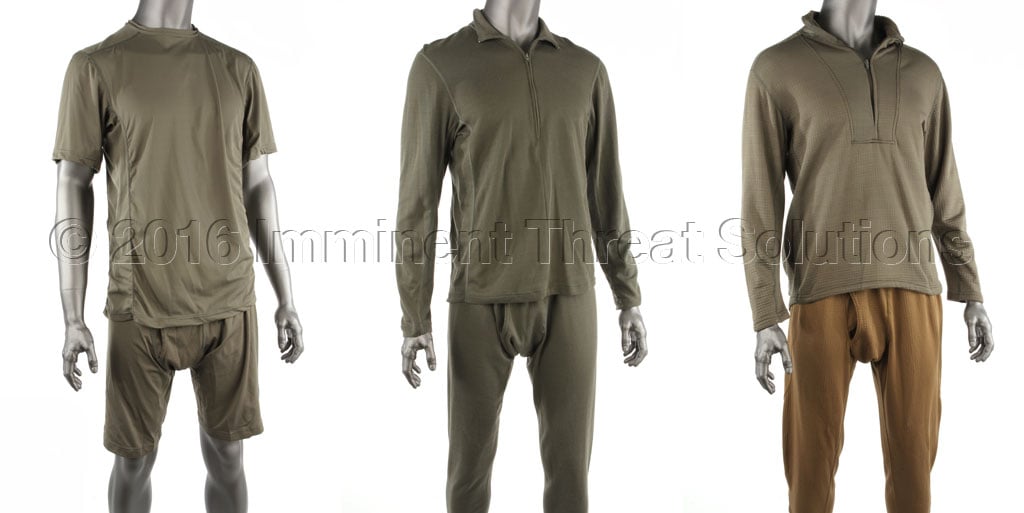
Some Block 0 pieces can still be obtained from ORC Industries, though they no longer actively produce the garments. Wild Things Gear still has some stock from when they held a PCU contract and Defense Outfitter was the go-to spot for a selection of Halys/Sekri PCU garments, but they’ve largely dried up. Naturally enough, individual garments from the various iterations of the PCU pop up from time to time on eBay. Ontario Geardo also maintains a great list on his site of various online PCU retailers, but again, most of these no longer have available stock.
While the currently produced offerings tend to be a little on the expensive side, buying equivalent garments from top notch outdoor clothing manufacturers is also going to cost you a pretty penny. As an added benefit, the entire PCU system is, as a result of the Berry Amendment, produced entirely in the United States of America.
One last important note to mention on sizing is that the PCU is made to layer. Meaning that if you’re a Medium, you’ll be a medium in each garment. The increased bulk of layering is accounted for with each piece, so there’s no need to go up a size on any individual layer.
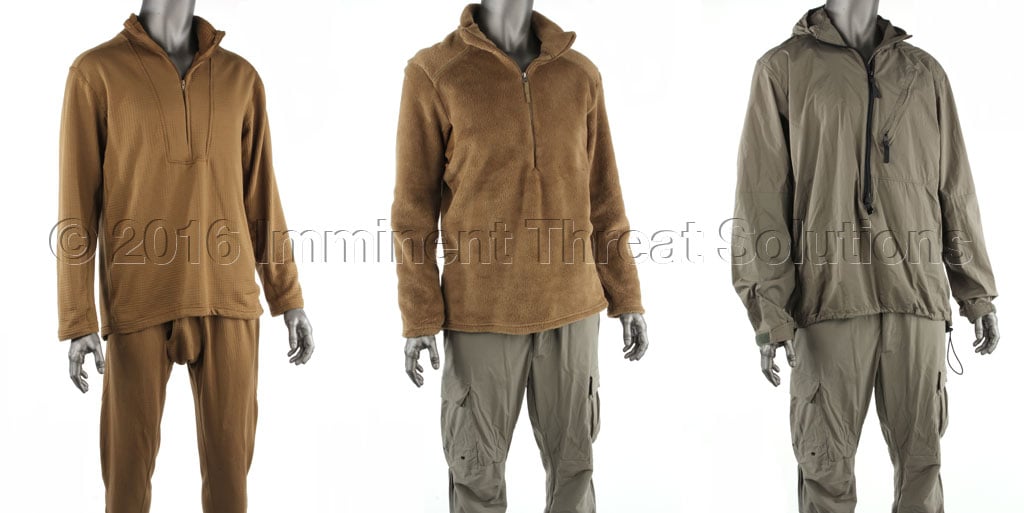
There is no doubt that the PCU system will continue to be revised and improved over time and those revisions will percolate throughout the rest of armed forces’ clothing systems. The ECWCS system, in particular, now in its Generation III iteration, has changed drastically over time and currently shows a great deal of influence from the PCU system. More on the ECWCS and PCU can be found here in the following ADS article written by Eric Graves of Soldier Systems.
Many sources were utilized in the research gathered to produce this article on ITS, which are listed below. We’d like to stress again that the secondary market, i.e. eBay, can be your best source for the various garments that make up the PCU. Additionally this can be a huge cost savings over buying new, but you are buying used clothing, if you’re somehow averse to that.
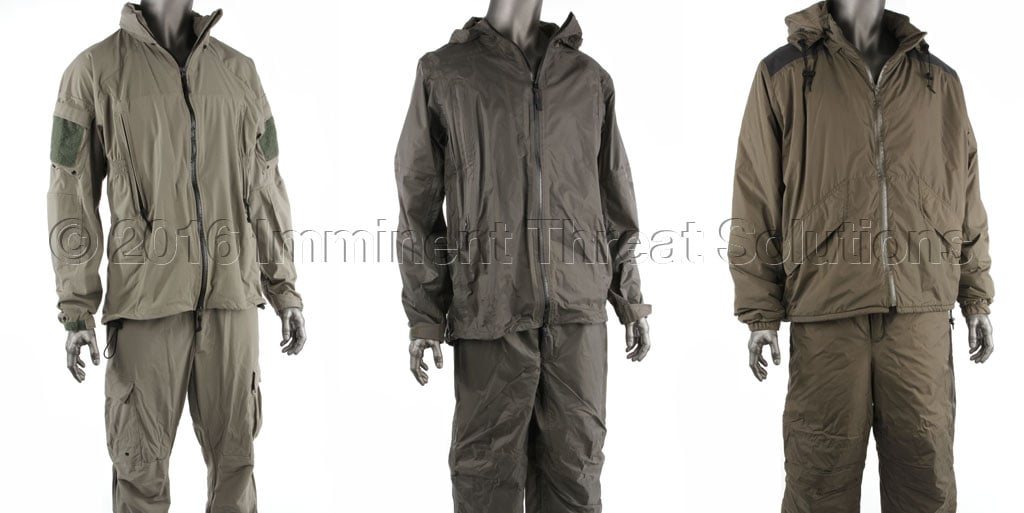
Hopefully you’ve learned a lot about the Protective Combat Uniform and we’d encourage you to share any information in the comments below concerning PCU history or purchasing resources online that might help others.
Sources
- SSC-Natick – Uniform Covers “Special” Field Request
- Backpacker – Stone Cold Campers
- ADS – Environmental Clothing Systems
- Soldier Systems – Block 2 Preview
- U.S. Navy Photos by Mass Communication Specialist 2nd Class Erika N. Manzano/Released






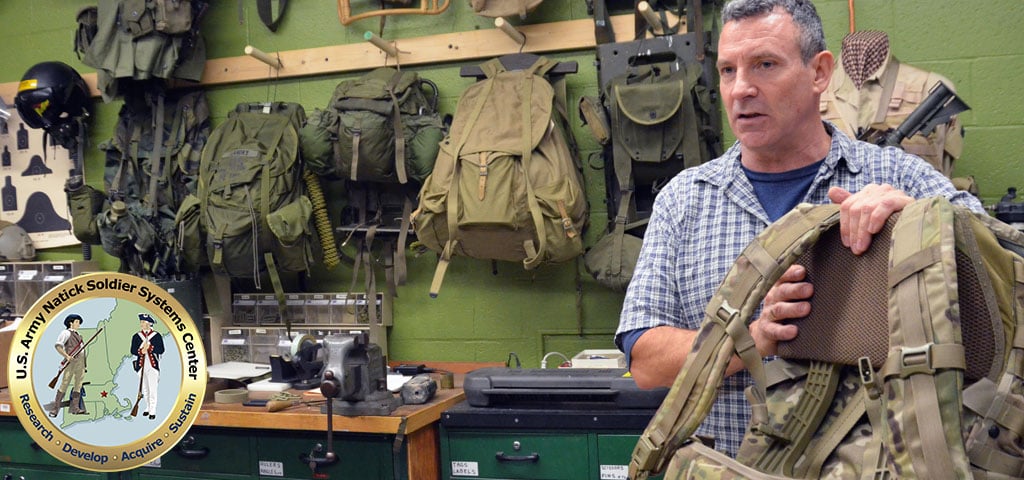

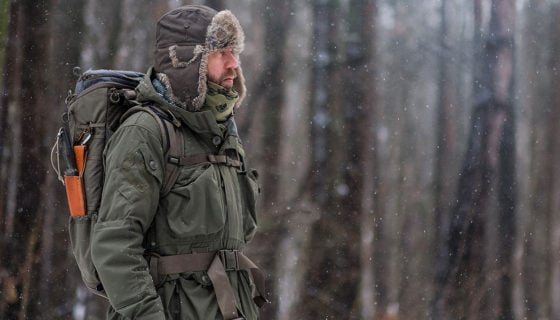
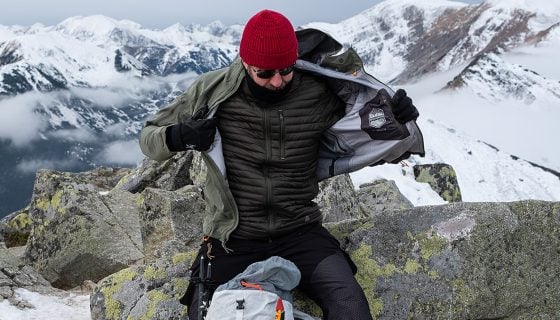

Discussion